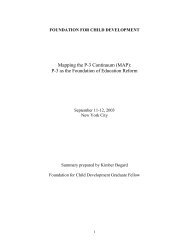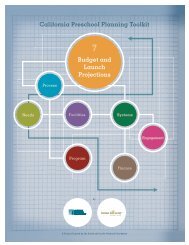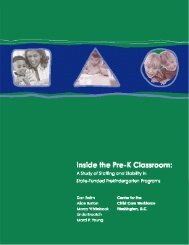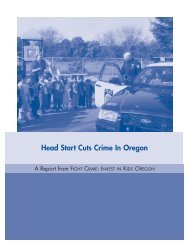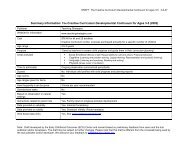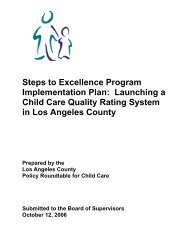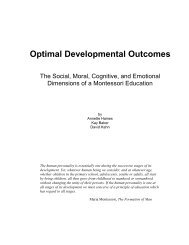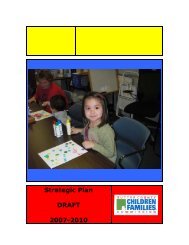Download this file - Plan4Preschool
Download this file - Plan4Preschool
Download this file - Plan4Preschool
You also want an ePaper? Increase the reach of your titles
YUMPU automatically turns print PDFs into web optimized ePapers that Google loves.
Career Technical Education <br />
An important part of the work of the California Department of Education (CDE) is to<br />
strengthen the relationship between a strong kindergarten through adult education and<br />
California’s workforce development and economic future. That future depends on the<br />
state’s ability to develop a competitive workforce for the knowledge-based, global<br />
economy of the twenty-first century. The CDE’s perspective has broadened from the<br />
traditional vocational (now career technical) education curriculum to a multifaceted<br />
concept incorporating career preparation and workforce development. Elements include<br />
integrating academic and career technical education (CTE) curricula, adding or<br />
modifying workforce development programs, and expanding partnerships linking<br />
education with business and industry.<br />
The focus of CTE has expanded from the traditional occupation-specific job entry<br />
preparation within subject matter areas—agriculture, arts and communications,<br />
business, health careers, home economics, and industrial and technology education—to<br />
an “industry sector” approach. For example, industrial and technology education is now<br />
composed of the following industry sectors: building trades and construction, energy<br />
and utilities, transportation, manufacturing and product development, and engineering<br />
and design. These are five of the fifteen industry sectors in California.<br />
This approach provides integrated, sequential programs of instruction designed to build<br />
on the academic preparation of students as well as on their experiences, interests,<br />
skills, and prior knowledge of practices and procedures. Partnerships between business<br />
and industry sectors and various educational levels are emphasized, as are learning<br />
strategies that connect across the disciplines. The CDE also works with professional<br />
and student organizations in offering technical assistance and professional<br />
development.<br />
The Carl D. Perkins Vocational and Technical Education Act of 1998 provides funding to<br />
improve CTE programs in secondary and postsecondary schools. Through the Perkins<br />
State Plan, California articulates state policy that drives CTE planning and programs in<br />
public schools. That state policy is built on high standards for all students. California has<br />
made great progress in defining basic academic and employability skills that every<br />
student should master in order to earn a high school diploma. The underlying premise is<br />
that all students should develop these basic competencies to become productive<br />
workers, contributing members of the community, lifelong learners, and successful<br />
family members. The State Board of Education adopted CTE Model Curriculum<br />
Standards in May 2005 and adopted the Instructional Framework for CTE in January<br />
2007.<br />
Current systemic programs and initiatives include:<br />
Regional Occupational Centers and Programs (ROCPs) have constituted the state’s<br />
largest workforce preparation system for over 30 years. The 74 ROCPs in California<br />
provide over 500,000 high school and adult students with CTE so students can<br />
92



